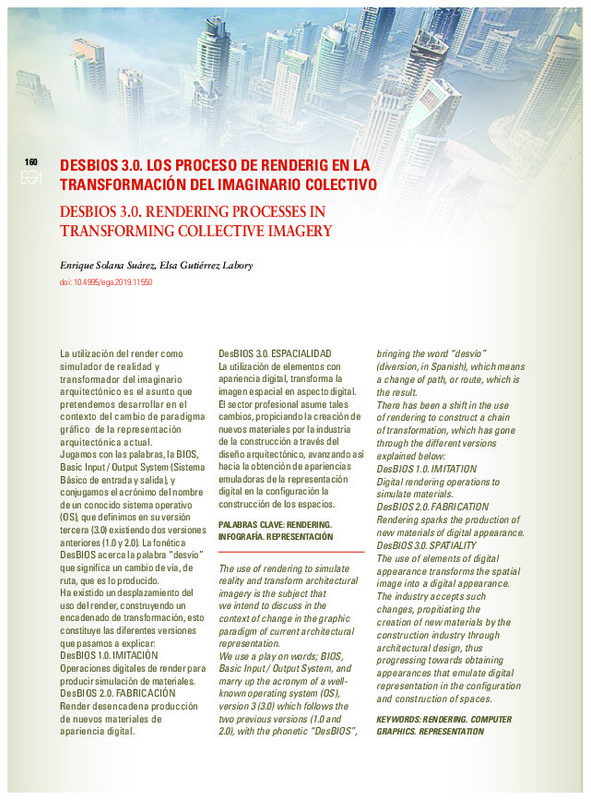JavaScript is disabled for your browser. Some features of this site may not work without it.
Buscar en RiuNet
Listar
Mi cuenta
Estadísticas
Ayuda RiuNet
Admin. UPV
DesBIOS 3.0. Los proceso de rendering en la transformación del imaginario colectivo
Mostrar el registro sencillo del ítem
Ficheros en el ítem
| dc.contributor.author | Solana Suárez, Enrique
|
es_ES |
| dc.contributor.author | Gutiérrez Labory, Elsa
|
es_ES |
| dc.date.accessioned | 2019-04-10T12:36:54Z | |
| dc.date.available | 2019-04-10T12:36:54Z | |
| dc.date.issued | 2019-04-08 | |
| dc.identifier.issn | 1133-6137 | |
| dc.identifier.uri | http://hdl.handle.net/10251/119192 | |
| dc.description.abstract | [EN] The use of rendering to simulate reality and transform architectural imagery is the subject that we intend to discuss in the context of change in the graphic paradigm of current architectural representation. We use a play on words; BIOS, Basic Input / Output System, and marry up the acronym of a wellknown operating system (OS), version 3 (3.0) which follows the two previous versions (1.0 and 2.0), with the phonetic “DesBIOS”, bringing the word “desvío” (diversion, in Spanish), which means a change of path, or route, which is the result. There has been a shift in the use of rendering to construct a chain of transformation, which has gone through the different versions explained below: DesBIOS 1.0. IMITATION Digital rendering operations to simulate materials. DesBIOS 2.0. FABRICATION Rendering sparks the production of new materials of digital appearance. DesBIOS 3.0. SPATIALITY The use of elements of digital appearance transforms the spatial image into a digital appearance. The industry accepts such changes, propitiating the creation of new materials by the construction industry through architectural design, thus progressing towards obtaining appearances that emulate digital representation in the configuration and construction of spaces. | es_ES |
| dc.description.abstract | [ES] La utilización del render como simulador de realidad y transformador del imaginario arquitectónico es el asunto que pretendemos desarrollar en el contexto del cambio de paradigma gráfico de la representación arquitectónica actual. Jugamos con las palabras, la BIOS, Basic Input / Output System (Sistema Básico de entrada y salida), y conjugamos el acrónimo del nombre de un conocido sistema operativo (OS), que definimos en su versión tercera (3.0) existiendo dos versiones anteriores (1.0 y 2.0). La fonética DesBIOS acerca la palabra “desvío” que significa un cambio de vía, de ruta, que es lo producido. Ha existido un desplazamiento del uso del render, construyendo un encadenado de transformación, esto constituye las diferentes versiones que pasamos a explicar: DesBIOS 1.0. IMITACIÓN Operaciones digitales de render para producir simulación de materiales. DesBIOS 2.0. FABRICACIÓN Render desencadena producción de nuevos materiales de apariencia digital. DesBIOS 3.0. ESPACIALIDAD La utilización de elementos con apariencia digital, transforma la imagen espacial en aspecto digital. El sector profesional asume tales cambios, propiciando la creación de nuevos materiales por la industria de la construcción a través del diseño arquitectónico, avanzando así hacia la obtención de apariencias emuladoras de la representación digital en la configuración la construcción de los espacios. | es_ES |
| dc.language | Español | es_ES |
| dc.language | Inglés | es_ES |
| dc.publisher | Universitat Politècnica de València | |
| dc.relation.ispartof | EGA. Revista de Expresión Gráfica Arquitectónica | |
| dc.rights | Reconocimiento - No comercial - Sin obra derivada (by-nc-nd) | es_ES |
| dc.subject | Rendering | es_ES |
| dc.subject | Infografía | es_ES |
| dc.subject | Representación | es_ES |
| dc.subject | Computer graphics | es_ES |
| dc.subject | Representation | es_ES |
| dc.title | DesBIOS 3.0. Los proceso de rendering en la transformación del imaginario colectivo | es_ES |
| dc.title.alternative | DesBIOS 3.0. Rendering processes in transforming collective imagery | es_ES |
| dc.type | Artículo | es_ES |
| dc.date.updated | 2019-04-10T07:23:04Z | |
| dc.identifier.doi | 10.4995/ega.2019.11550 | |
| dc.rights.accessRights | Abierto | es_ES |
| dc.description.bibliographicCitation | Solana Suárez, E.; Gutiérrez Labory, E. (2019). DesBIOS 3.0. Los proceso de rendering en la transformación del imaginario colectivo. EGA. Revista de Expresión Gráfica Arquitectónica. 24(35):160-167. https://doi.org/10.4995/ega.2019.11550 | es_ES |
| dc.description.accrualMethod | SWORD | es_ES |
| dc.relation.publisherversion | https://doi.org/10.4995/ega.2019.11550 | es_ES |
| dc.description.upvformatpinicio | 160 | es_ES |
| dc.description.upvformatpfin | 167 | es_ES |
| dc.type.version | info:eu-repo/semantics/publishedVersion | es_ES |
| dc.description.volume | 24 | |
| dc.description.issue | 35 | |
| dc.identifier.eissn | 2254-6103 | |
| dc.description.references | SEGUÍ DE LA RIVA, J. 2000-2006. Escritos para una Introducción al Proyecto. Instituto Juan de Herrera. Madrid. | es_ES |
| dc.description.references | SHKLYAR, DMITRY. 2002. 3D Rendering History. CGNetwork Features. ww.cgsociety.org/CGSFeatures/CGSFeatureSpecial/custom_story/1647&page | es_ES |
| dc.description.references | SOLANA SUÁREZ, E. 2007. "Utilidad Frente al Operador en la Expresión Gráfica Arquitectónica". EGA: Revista Expresión Gráfica Arquitectónica Nº 12. Valencia. https://doi.org/10.4995/ega.2007.10292 | es_ES |
| dc.description.references | SOLANA SUÁREZ, E. GUTIÉRREZ LABORY, E. 2015. "Croquis y Diagramas en momentos iniciales del Diseño Arquitectónico". EGA: Revista Expresión Gráfica Arquitectónica. Valencia. https://doi.org/10.4995/ega.2015.4043 | es_ES |
| dc.description.references | SOLANA SUÁREZ, E. GUTIÉRREZ LABORY, E. 2017. Paradigma gráfico para la arquitectura actual. EGA: Revista Expresión Gráfica Arquitectónica (en prensa). Valencia. https://doi.org/10.4995/ega.2017.7831 | es_ES |
| dc.description.references | SUTHERLAND, IVAN. 1963. Sketchpad: The First Interactive Computer Graphics. MIT, 1963. | es_ES |








